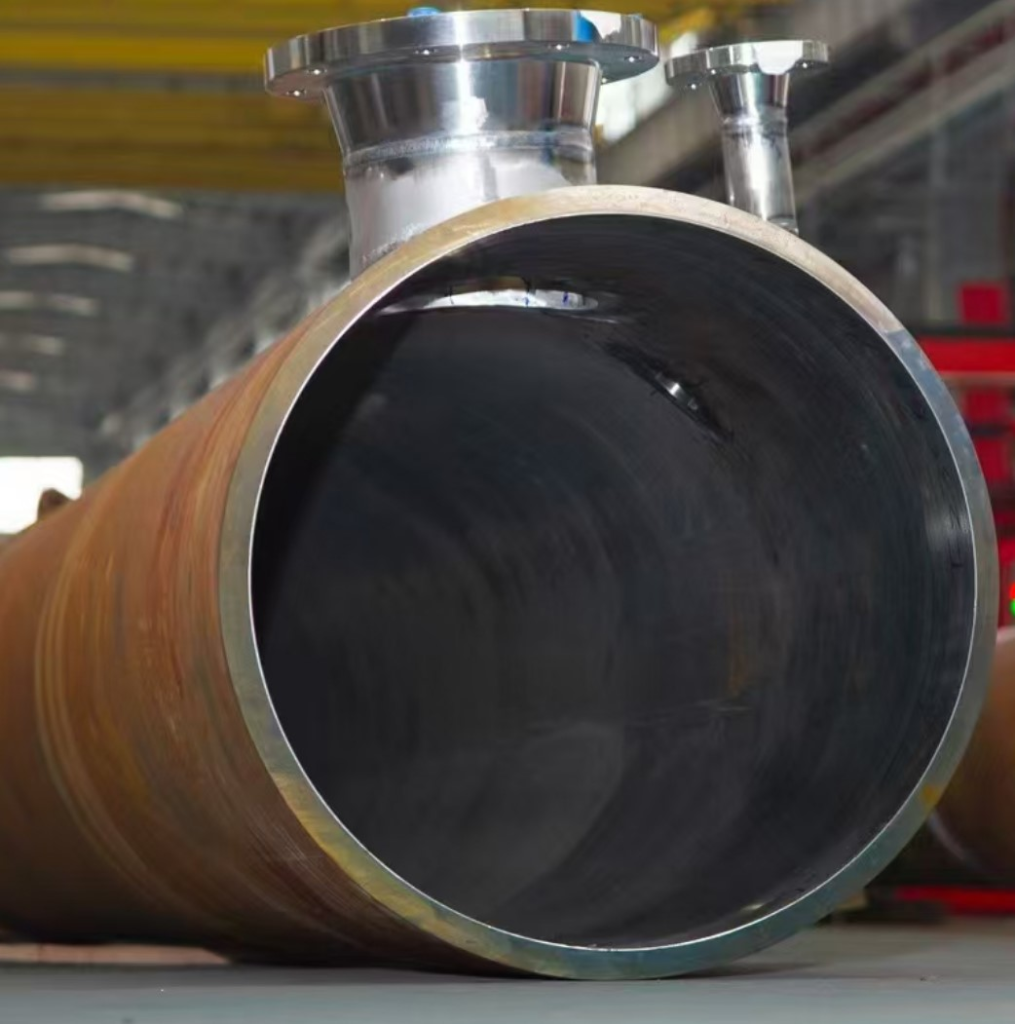Key Technical Requirements of API 5LD: Materials, Dimensions, and Tolerances
For CRA (corrosion-resistant alloy) clad and lined steel pipes to meet demanding field conditions, compliance with API 5LD requires more than surface-level precision. The standard outlines strict criteria for materials, dimensional controls, and bonding integrity—each playing a crucial role in product performance.
In this article, we examine the core technical requirements of API 5LD, helping buyers, engineers, and manufacturers understand what ensures reliability in every pipe section.

API 5LD CRA clad pipe in FNS workshop
Materials Defined in API 5LD
A defining feature of CRA clad and lined pipes is their dual-material structure. API 5LD specifies both the base material (load-bearing) and the CRA layer (corrosion-resistant).
1. Base Material (Carbon or Low Alloy Steel)
- Often grades such as API 5L X52, X60, or ASTM A516
- Selected for strength, weldability, and compatibility with clad/lined processes
- Must meet chemical and mechanical property standards
2. CRA Layer (Corrosion-Resistant Alloy)
- Common choices include:
- Austenitic stainless steels (e.g., 316L, 317L)
- Duplex stainless steels (e.g., UNS S31803)
- Nickel-based alloys (e.g., Alloy 625, Alloy 825)
- CRA materials must maintain resistance to pitting, crevice, and intergranular corrosion
FNS uses strict raw material screening and heat treatment procedures to ensure interfacial bonding quality and corrosion performance.
Dimensional Requirements
API 5LD sets clear limits for dimensional tolerance to guarantee proper fit-up during field welding and long-term service integrity.
Outside Diameter (OD) and Wall Thickness (WT)
- OD tolerance follows standard pipe specifications (typically ±0.75% for seamless)
- WT tolerance is particularly important for CRA pipes due to:
- Pressure containment
- Lining/cladding process stability
- CRA layer thickness must also meet minimum values (often ≥2.5 mm) and be uniform along the pipe length
Ovality and Straightness
- Ovality (out-of-roundness) should not exceed 2%
- Straightness deviation is tightly controlled to ensure pipeline alignment
CRA Bonding Methods
API 5LD permits several methods for applying the CRA layer to the base metal:
| Method | Description | Typical Use Case |
|---|---|---|
| Hot-roll bonding | CRA plate is bonded during hot rolling | High-strength applications |
| Weld overlay | CRA applied via arc welding (e.g., GTAW) | Small-batch, custom pipes |
| Explosion bonding | High-energy detonation forms metallurgical bond | Thick-wall sections |
| Mechanical lining | CRA tube inserted and expanded mechanically | Economical for lower pressure |
Each method requires strict bond integrity testing, including ultrasonic testing (UT) and shear strength validation.
Tolerances and Testing
API 5LD mandates both dimensional and performance-based tolerances, with verification through destructive and non-destructive testing (NDT):
- Dimensional checks: OD, WT, CRA layer thickness
- Visual inspection: Surface finish, weld quality, signs of delamination
- Non-destructive tests: UT, RT for bond line and CRA integrity
- Shear testing: To confirm metallurgical bonding strength
- Corrosion test coupon evaluation (if required by client/project specs)
At FNS, we implement in-process and final dimensional verification using laser profile gauges and ultrasonic mapping to ensure conformance with API 5LD.
Typical Tolerance Examples (as per API 5LD)
| Parameter | Tolerance |
|---|---|
| Wall thickness (WT) | –12.5% / +15% (typical, varies by grade) |
| CRA layer thickness | ±0.3 mm (project-specific) |
| Outside diameter (OD) | ±0.75% |
| Ovality | ≤2% |
The technical framework established by API 5LD is more than a checklist—it is the foundation for delivering safe, long-lasting CRA clad and lined pipes. For manufacturers like FNS, strict adherence to dimensional and material controls ensures not only compliance but long-term customer confidence.
In the next article, we’ll explore how these materials and dimensions are translated into real production—through cladding, welding, and testing processes under API 5LD.
Related Articles:
←Manufacturing CRA Clad and Lined Pipes Under API 5LD: From Cladding to Inspection
→ What is API 5LD? Clad & Lined Steel Pipes for Corrosion‑Resistant Service


